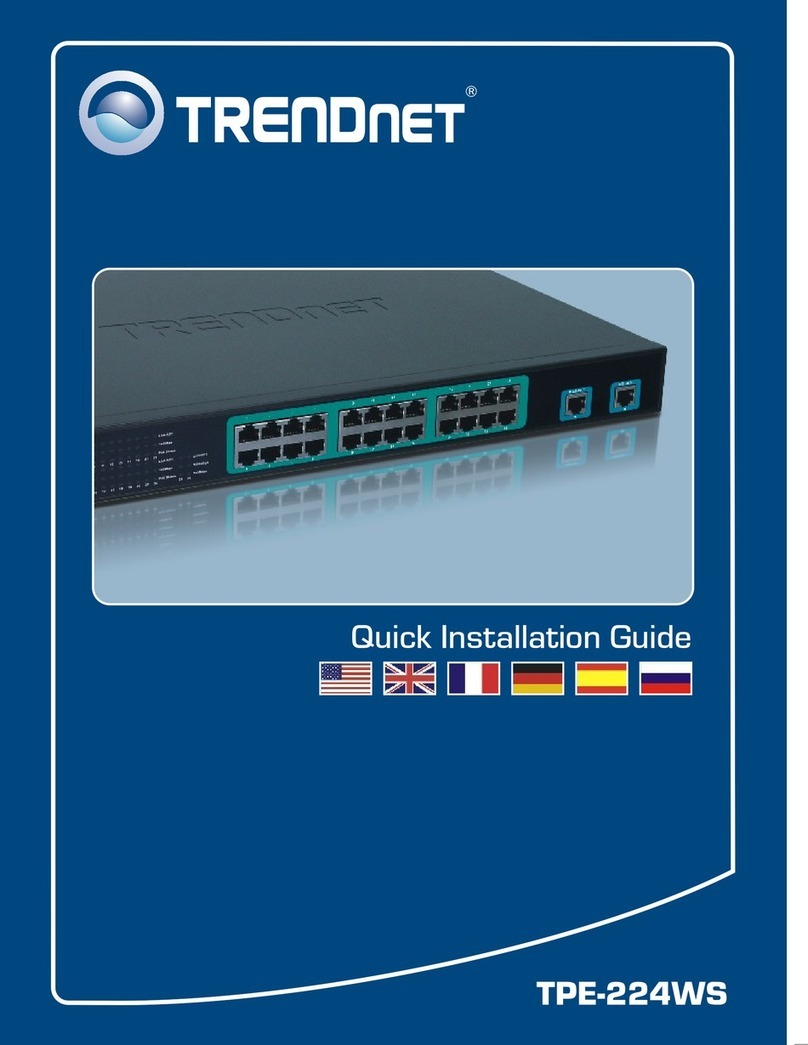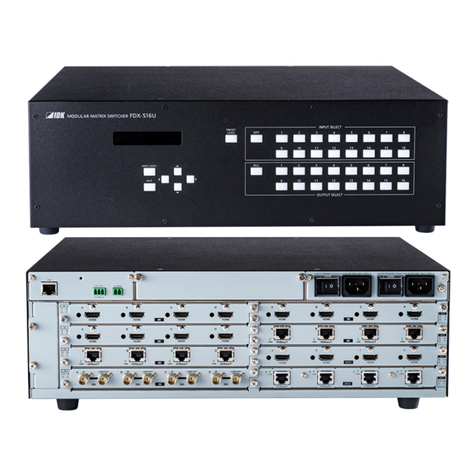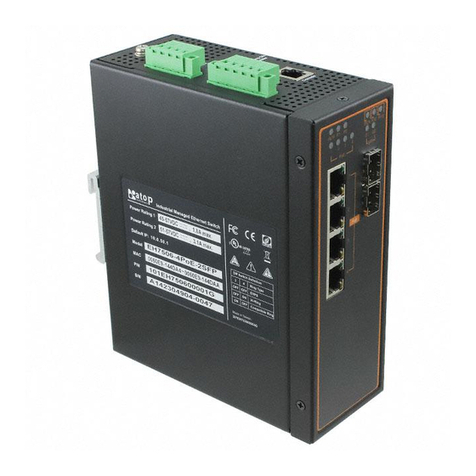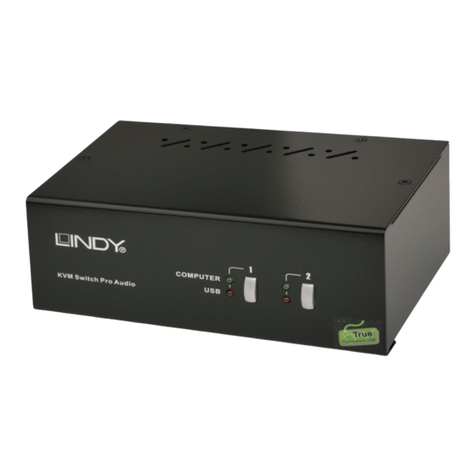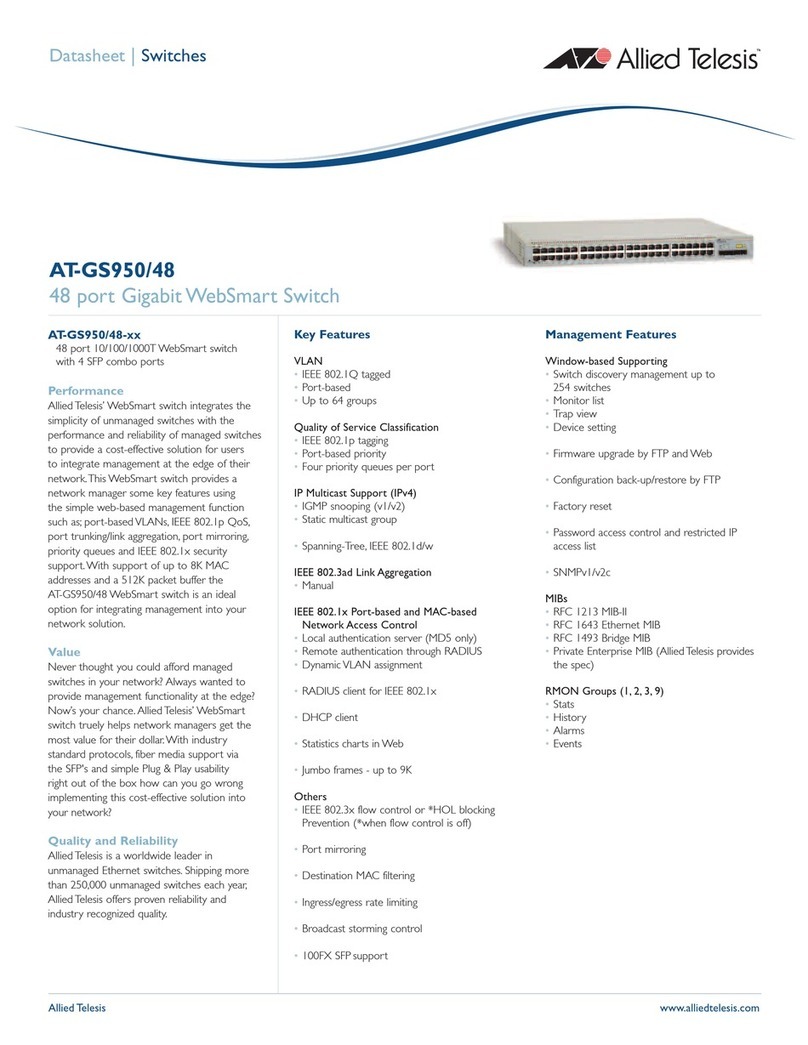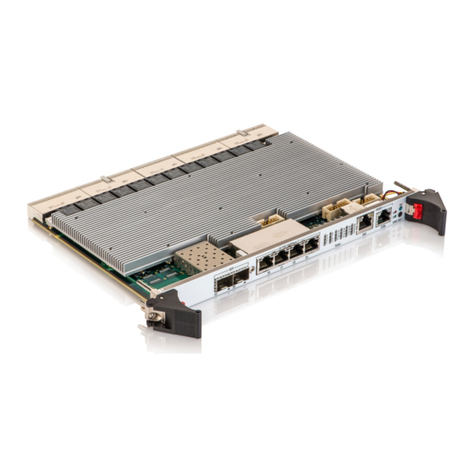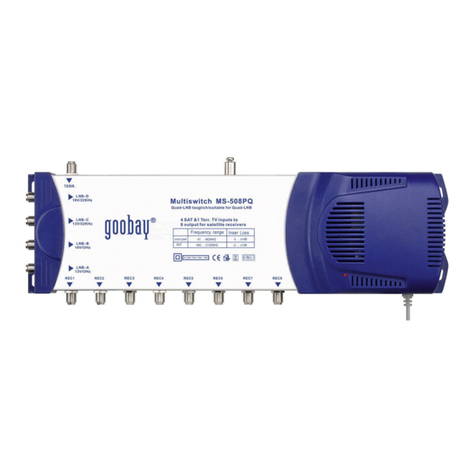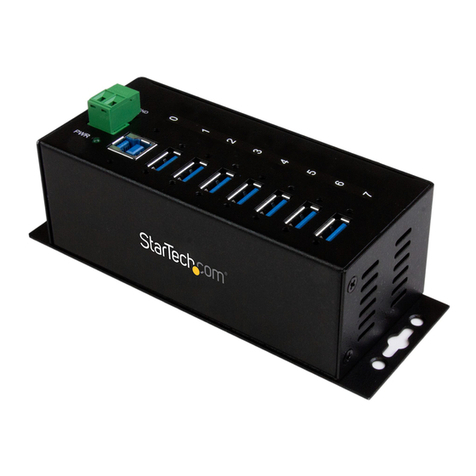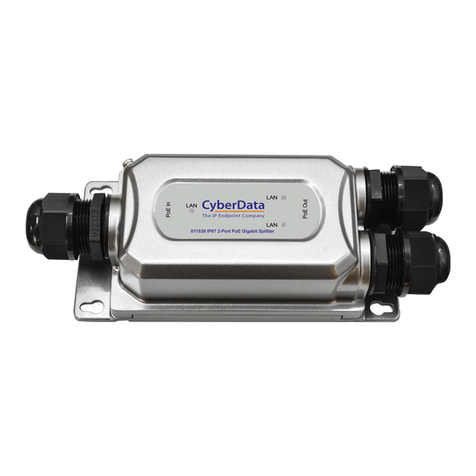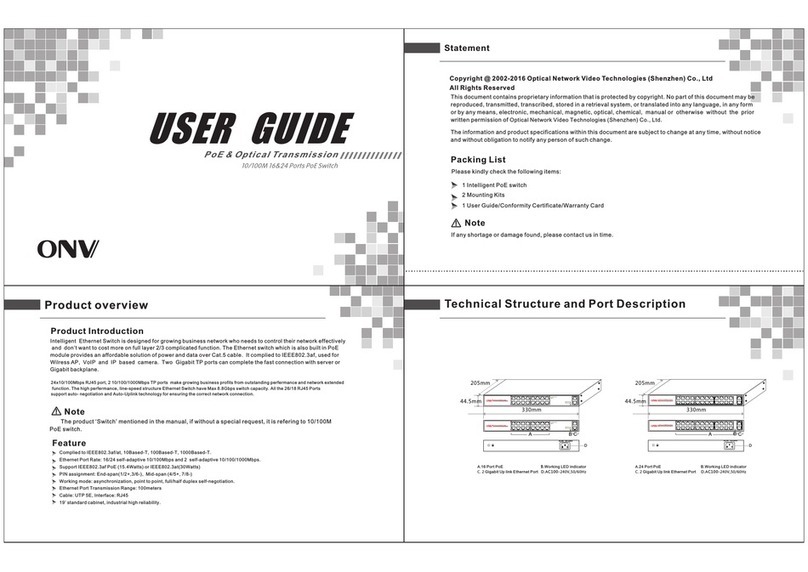CCS LSS-2404 User manual

Version 2.0E
LSS-2404
User’s Manual
www.computationalimaging.com
www.ccsamerica.com
Light Sequence Switch

Copyright and Disclaimer Notice
Except as prohibited by law:
All hardware, software and documentation is provided on an ‘as is’ basis.
This information is for guidance only. Installers must perform their own
risk assessment specific to each installation.
It is essential that the user ensures that the operation of the product is
suitable for their application.
The user must ensure that incorrect functioning of this equipment
cannot cause any dangerous situation or significant financial loss to
occur.
Deliberate acts of endangerment and vandalism are not covered by this
document and must be considered by the installer.
While care has been taken in the preparation of this document, CCS
America, Inc. and CCS Inc. will not accept any liability for consequential
loss of any kind except those required by law.
All trademarks acknowledged. Hardware, software and documentation
are Copyright 2018 CCS America, Inc.
EC Conformity Declaration
The EC Certificate of Conformity is available from CCS America, Inc. on
request.
Issue status of this document: Issue v2.0E (July 2018)

LSS-2404
Contents
Introduction ..................................................................................................................................................1
Getting Started..........................................................................................................................................1
Features ....................................................................................................................................................1
Included Components...........................................................................................................................1
Required Components ..........................................................................................................................1
Optional Accessories.............................................................................................................................1
Safety Precautions ....................................................................................................................................2
LSS Overview.............................................................................................................................................3
Terminology ..........................................................................................................................................3
Principle of Operation...........................................................................................................................4
Hardware Information ..................................................................................................................................6
Environmental Considerations..................................................................................................................6
Hardware ..................................................................................................................................................6
LSS Controller........................................................................................................................................6
Camera..................................................................................................................................................8
Lighting..................................................................................................................................................8
Connection Requirements ..........................................................................................................................10
Power Supply/Consumption...................................................................................................................10
Specifications ......................................................................................................................................10
Selecting Power Supply.......................................................................................................................11
Ethernet Connection...............................................................................................................................11
Trigger Input............................................................................................................................................12
Trigger Output.........................................................................................................................................13
Lighting Output .......................................................................................................................................14
Setup LSS Controller....................................................................................................................................14
Wiring......................................................................................................................................................14
Power Supply ......................................................................................................................................14
Lighting................................................................................................................................................14
Trigger.................................................................................................................................................14

LSS-2404
Ethernet ..............................................................................................................................................15
Camera................................................................................................................................................15
Operating Modes ....................................................................................................................................15
Mounting.................................................................................................................................................16
Orientation..........................................................................................................................................16
Height..................................................................................................................................................18
Software Operation ................................................................................................................................19
Quick Start...........................................................................................................................................19
Update Firmware ................................................................................................................................21
Change IP address...............................................................................................................................22
Settings Operations.............................................................................................................................23
Recipe Settings....................................................................................................................................25
Sequence Settings...............................................................................................................................26
Frame Settings ....................................................................................................................................26
GUI Settings.........................................................................................................................................28
Summary.............................................................................................................................................28
Motion Correction...............................................................................................................................29
Troubleshoot.......................................................................................................................................30
Appendix .....................................................................................................................................................32
A. LSS-2404 Specifications...................................................................................................................32
B. Mechanical Drawing .......................................................................................................................35
C. Timing Diagrams for Triggering.......................................................................................................36
D. Connection Diagram .......................................................................................................................40
E. API Commands................................................................................................................................46
F. Multi Shot Imaging Examples..........................................................................................................57

LSS-2404
1 | P a g e
Introduction
Getting Started
This user manual describes the set up and basic operation of the LSS-2404 lighting controller, as well as the
corresponding configuration software. Before using it, please read the manual carefully to ensure proper use.
After reading the manual keep it in an easily accessible location for future reference.
Read Safety and Specifications and check that the LSS-2404 controller fulfills your requirements.
An LSS quick start set up guide is available on pg. 19 once wiring and mounting is completed. This manual is
specific to the computational imaging technique photometric stereo. If you need instructions for other
techniques contact CCS America, Inc.
This manual was published for firmware version FW1_10_11. When firmware updates are available release
notes will be included for further information.
Features
The LSS has ethernet capabilities and 4 channel outputs. Each output can control a segment of a 4-segment light
or an independent light.
Included Components
One LSS controller and one instruction card are included in the package. The Instruction Card contains a link to
download the latest software, manual and other resources for the LSS-2404. Make sure everything is in place
before proceeding.
Required Components
To correctly set up the LSS you will need the following items:
•LSS Controller
•LSS Web based software
oThe LSS software can be accessed by the link below
▪http://bit.ly/LSSCI
oNote: the LSS software only works with a Firefox browser (version 56 or above) or Microsoft
Edge
•Compatible Lights (e.g. segmented ring light or bar light sets) and corresponding cables
•Compatible Cameras and software
Optional Accessories
An assortment of extension cables, break out cables, and mounting brackets can be purchased to accommodate
various installation requirements and any CCS lights. More information is available on pg. 8.

LSS-2404
2 | P a g e
Safety Precautions
Read this section before using the LSS-2404. Always observe the following safety precautions. If in doubt,
contact CCS America, Inc. The following symbols are used in this guide:
Warning: Read the instructions to understand the possible hazards.
Warning: Surface may get hot.
Warning: Possible hazardous voltage.
Refer to the text in this section for precautions you should take whenever the above symbols appear in this
guide.
Heat
Ensure that the LSS-2404 is mounted correctly (see Mounting the LSS-2404),
and that you do not exceed any of the ratings for the unit (see Specifications
and Ratings).
At its maximum ratings, the LSS-2404’s enclosure cannot exceed 50 °C,
which is sufficient to cause a burn if touched.
Place the unit in a position where personnel cannot accidentally touch it and
ensure there is a free flow of air around the unit.
Electrical
The LSS-2404 produces high energy pulses.
Take care to connect the outputs correctly and protect the output wiring and
load from any short-circuits.
When switched off, energy may remain stored in the 2404 for a few seconds.
Use caution with connections immediately after shut down.
The 2404 does not have complete tracking isolation of input and output.
Transients caused by inductive loads must be suppressed externally to the 2404.
The LSS-2404 is a Class B device intended for industrial or commercial
applications, even though it does conform within Class A emission limits which
are stricter for residential use. If any unwanted interference does occur, cable
shielding, grounding, and the product installation should be reviewed by the
user to restrict emissions to a level that prevents interference with broadcast
transmissions.
General
The LSS-2404 must not be used in an application where its failure could be a danger
to personal health or damage to other equipment.

LSS-2404
3 | P a g e
LSS Overview
Terminology
Recipe Settings
Fixed settings for each recipe that do not vary across the frames or sequences (to be defined later). These are
considered global parameters that are set once in the recipe. Trigger Type, trigger event, trigger level, trigger
delay, output trigger delay, ground trigger, camera trigger voltage, and camera trigger width make up recipe
settings.
Active Settings
Settings the LSS are currently running which are loaded into RAM. Active settings reside in volatile memory and
will not be saved when power is lost unless stored to flash memory.
Saved Settings
Settings in persistent storage, either onboard flash memory or PC files. Active settings can become Saved
settings when using the Save to Controller or Save to File commands.
Sequence Settings
Settings that are defined within each sequence thus can vary between different sequences. Executions, number
of frames, and channel mapping are considered Sequence settings
Frame Settings
In most cases, these settings apply across all frames in a sequence. However, an Advanced Mode allows you to
set different strobe widths from frame to frame within a sequence. Frame time, strobe width, frame rate,
independent strobe widths, and independent widths make up the Frame Settings.
Frames
Every frame is an image the camera captures with the programmed lighting channels. Multiple frames are
combined to create sequences and multiple sequences can be linked to create a recipe. There is a maximum of
12 frames per sequence.
Channels
Channels refer to output channels for attached lighting. Lights attached to the LSS may either be segmented
lights or independent lights. Dedicated computational imaging lights, such as the HPR2-150SW2-DV04, have pre-
wired segments connected to each channel. When using a breakout cable connected to any individual CCS lights,
the user will connect each light to a channel. Checking the corresponding Channel box within a Frame turns that
segment or connected light on for the set exposure time for that Frame.
Sequences
The number of frames and their settings make up one sequence. When a sequence is completed the camera
software is able to complete one output image. There can be 10 different programmed sequences on the LSS
controller, but each sequence can be programmed to execute multiple times.

LSS-2404
4 | P a g e
Recipe
Recipes are made up of multiple sequences. There can only be 6 defined recipes on the LSS controller. Each
recipe has its own recipe settings.
Trigger
Typically, triggers are sent directly to a smart camera and light simultaneously; using the LSS, the trigger is sent
to the LSS controller. The LSS controller then sends outputs to the camera and light at the programmed
intervals. Timing Diagrams are available in Appendix C.
Raw Images
Images that are captured based on the settings of each frame. They are then compiled together in the camera
software to create enhanced output images, sometimes referred to as “super images” because of their unique
characteristics; e.g. photometric stereo (PMS) images.
Output Images
Images resulting from combining raw frame images into one final image. In the case of PMS, the 4 raw images
create two output images; one shape image and one texture image.
Principle of Operation
The LSS-2404 is a programmable device that can be used to create multiple types of images. It is configured
from a standard web browser and can store and execute arbitrarily complex lighting sequences for multi-shot
imaging. The architecture is flexible and consists of recipes, sequences, and frames. Each frame corresponds to
one captured image and synchronous strobe output (light flash). Multiple frames together form a sequence and
each sequence results in an inspection image (output image). This output image can result from multiple images
merged via a computational imaging technique, or an image achieved with traditional lighting. Frames can have
their own settings per sequence. In addition, sequences can be set to repeat multiple times and every sequence
in a recipe can have different settings.
Multiple sequences combine to form a recipe. The recipe is the highest level of organization and can be thought
of as the instructions for creating a set of multi-shot and/or conventional images. Each recipe can have its own
global settings. The LSS-2404 can store up to 6 recipes in flash memory, but additional recipes can be created
and saved to the PC and loaded into the LSS-2404 when necessary.
When the LSS-2404 controller is powered up the last saved settings are loaded from internal flash memory. A
different recipe (i.e. configuration) can be uploaded from the PC via the LSS-2404 software if desired.

LSS-2404
5 | P a g e
The image below illustrates the LSS-2404 architecture with relation to the settings.
Once a trigger activates the LSS-2404 controller, it begins to run the programmed recipe. The recipe can have up
to 10 different programmed sequences. Within one sequence, you determine how many frames to take and
which lights or light segments will turn on for each frame. Multiple lighting patterns are made by enabling
different channels within each frame −this is also known as channel mapping. Every sequence creates one type
of image for the camera software.
Once the channel mapping of a sequence has been determined, choose the number of times the sequence
executes. Once the LSS-2404 is triggered it will run the sequence through for the specified number of times
before moving onto the next sequence. For example, setting a PMS sequence to execute 2 times will give the
camera software 8 raw images and therefore make 2 sets of output images (2 shape images plus 2 texture
images).
LSS Controller
Recipe 1
Sequence 1
Sequence 2
Frame 1
Frame 2
Frame 12
Sequence 10
Recipe 6
Sequence 1
Frame 1
Sequence 2
Sequence 10
Recipe Settings
Sequence Settings
Frame Settings
Recipe Settings
Sequence Settings
Frame Settings
…
…
…
…

LSS-2404
6 | P a g e
Hardware Information
This information is for guidance only. Installers must perform their own risk assessment specific to each
installation. While CCS America Inc. has taken extensive care in the preparations of this advice, CCS America Inc.
accepts no liability for damages of any kind except those required by law. Deliberate acts of endangerment and
vandalism are not covered by this document and must be considered by the installer.
Environmental Considerations
The 2404 does not have an IP rating and must be mounted so that moisture and dirt cannot enter the unit. Free
air can be used as a cooling method.
Information
Limits
Operating Temp range
0o –40o C (32o–104o F)
Operating Humidity Range
10% –80% (non-condensing)
Storage Temp
-10o –50o C (14o–122o F)
Hardware
LSS Controller
Ethernet –Connect to the computer
with an ethernet cable.
Lighting Output –The M12-5
lighting output connector directly
connects to dedicated CI lights or a
breakout cable for use with almost
any CCS light.
Power Input –Connect to 24 VDC
power supply with the polarity as
marked.
Trigger Out –Connect the Trigger
Out terminals to the camera’s
trigger input pins per the wiring
section below.
Trigger In –Connect the external
system’s trigger to Trigger In to start
the lighting sequence. The trigger
may be any voltage from 3.3 V to 24
VDC. See the Trigger Out section
below for more information.

LSS-2404
7 | P a g e
Mounting the LSS
The LSS is intended to be mounted to a standard DIN rail. Hook the top of the DIN rail mounting groove over the
rail, pull the spring loaded, red DIN rail lock to guide the bottom of the DIN rail mounting groove fully onto the
DIN rail, and release the lock. Press down the unit and lightly wiggle it to ensure that it is properly secured to the
DIN rail.
The illustration below shows the dimensions and key parts of an LSS controller
DIN Rail Lock
99
Status
Indicator
15
Power Input
118
35
Ethernet Jack
Trigger I/O
Lighting Output
Connector

LSS-2404
8 | P a g e
Camera
Any camera that is powered over ethernet and can send and receive outputs/inputs.
Lighting
Ring Lights
Standard HPR2 style ring lights are available in white in the sizes listed above. All ring lights use M12 style
connection cables. Different color lights are available by special order (red, blue, IR).
Cables
Extension cables can be used to increase the distance from the LSS controller to the light. A summary of cable
lengths is shown below.
Product #
Length
FCB-1-0.5SQM12-5M5F
1 m
FCB-3-0.5SQM12-5M5F
3 m
FCB-5-0.5SQM12-5M5F
5 m
FCB-9-0.5SQM12-5M5F
9 m
Bar Lights
A bar light configuration is used to create more contrast via adjusting the angle to produce more shade
information and/or can be used to increase the field of view of the inspection. Different sizes and colors are
available for square or rectangular imaging areas. A universal bar light bracket is available to accommodate
almost any size bar light configuration. Please contact CCS for more information.
Product #
Diameter
HPR2-50SW-DV04M12-5
50 mm
HPR2-75SW-DV04M12-5
75 mm
HPR2-100SW-DV04M12-5
100 mm
HPR2-150SW-DV04M12-5
150 mm
HPR2-200SW-DV04M12-5
200 mm
HPR2-250SW-DV04M12-5
250 mm

LSS-2404
9 | P a g e
Cables
Breakout Cables
Breakout cables allow all 4 lights to connect back to the LSS controller, so each light is considered its own
segment and can be controlled individually. The table below summarizes the connection types and cable
lengths.
Connector Style
CCS Series
Product #
Length
M12
CCS Standard
with M12 option
FCB-F-0.3-XS2
300 mm
FCB-F-0.9-XS2
900 mm
SM
CCS Standard
FCB-F-0.3-XS2-SM3
300 mm
FCB-F-0.9-XS2-SM3
900 mm
Extension Cables
To increase distance from the LSS controller to the light, or to increase the size of the inspection area, extension
cables must be used. They come in both connection styles, M12 and SM.
To increase the distance; 1 M12 cable is required to connect the end of the breakout cable to the LSS controller.
For a larger light arrangement 4 extension cables are required. One cable will connect the end of the light in the
arrangement to one of the breakouts on the breakout cable and repeat for all four lights. Below is a table of the
connector style and lengths.
Connector Style
CCS Series
Product #
Length
M12
Lights with M12
option or
as extension
cables
FCB-1-0.5SQM12-5M5F
1 m
FCB-3-0.5SQM12-5M5F
3 m
FCB-5-0.5SQM12-5M5F
5 m
FCB-9-0.5SQM12-5M5F
9 m
SM
CCS Standard
FCB-1
1 m
FCB-2
2 m
FCB-3
3 m
FCB-5
5 m
Please contact CCS for more information regarding custom size and configuration.
Female SM
Output
Channel 4
Output
Channel 1
Output
Channel 3
Output
Channel 2
Male M12
Female M12
Output
Channel 1
Output
Channel 2
Output
Channel 3
Output
Channel 4
Pin 5, CH 4 -
Pin 1, Common +
Pin 2, CH 1 -
Pin 3, CH 2 -
Gray
Black
Pin 4, CH 3 -
Brown
White
Blue
M12 Connection
Breakout Cable
FCB-F-x-XS2
SM Connection
Breakout Cable
FCB-F-x-SM3
Male M12

LSS-2404
10 | P a g e
Connection Requirements
A specification sheet of the LSS is in Appendix A.
Power Supply/Consumption
Specifications
The following specifications are for the LSS-2404 controller.
Information
Limits
Notes
Nominal Input Voltage
12 - 24 VDC
Max allows to work with most
12-24 VDC power supplies
10.8 - 28.8 VDC Maximum
Max Continuous Supply
Current
2.0A /channel
Do not connect lighting that
exceeds these limits
4.0 A total for all channels
Uses common ground power system*
Thermal Fuse**
1.5A PTC per channel
Prevent damage in fault
conditions related to individual
channels
Main Fuse***
7A
Protects all electrical
components from various issues
Power Consumption
5W
Excluding attached lighting and
dependent configuration
* The (-) power supply input, the (-) trigger input, the (-) trigger output and any grounded metal enclosures are
all electrically connected and treated as ground. This must be given proper consideration when making electrical
connections between the control box and other system components. Ensure that all components connected are
capable of having their low side (-) contacts joined and grounded without creating an electrical fault.
**PTC fuses are self-resettable and are designed to limit unsafe currents while allowing constant safe current
levels. Resistance will “reset” automatically when the fault is removed, and the temperature returns to a safe
level. In the event of a fault condition, remove power and the fault condition (if applicable) and wait five
minutes. Power the LSS-2404 back on to restore operation. The product warranty does not cover any damage
that may have occurred due to improper connection or operation.
***If the main fuse blows the LSS will appear to have no power or indicators. If this occurs the unit is not user
repairable and must be sent in to CCS America for repair.
Contact techsupport@ccsamerica.com, if the LSS-2404 needs repair.

LSS-2404
11 | P a g e
Selecting Power Supply
Choose a power supply that fulfills the requirements below
•Well-regulated 12-24 VDC with appropriate current rating for attached lights (5V minimum)
•Absolute voltage ratings are never exceeded in any installed operating conditions
oDamage may occur if the input exceeds the specified absolute limits.
•Total capacity at least equal to or greater than 100 mA PLUS the sum of all 4 channels of connected light
•Note: 24V with 4.1A or greater can run the maximum allowed lighting
•DO NOT USE power supplies with 10A capacity or larger
DO NOT USE THIS DEVICE WITH POWER SUPPLIES OR EXTERNAL COMPONENTS USING AN ISOLATED GROUND
SYSTEM THAT CANNOT BE CONNECTED TO AC GROUND. EXTERNAL COMPONENTS MUST SUPPORT A COMMON
GROUND SYSTEM.
To request configuration for use in floating or isolated ground systems, please contact CCS America by sending
an email to techsupport@ccsamerica.com
Ethernet Connection
Ethernet connectivity with TCP/IP protocol is standard on the 2404 controllers. The RJ45 Ethernet connector
requires a straight through cable to connect into a PC, network switch, hub or router. It operates at 100Mbits
per second (100 Base-T).
The IP address on the LSS-2404 is 192.168.0.10.

LSS-2404
12 | P a g e
Trigger Input
The LSS-2404 trigger input is a ground referenced 4.7K ohm resistive termination. It is designed to work with
most outputs on common devices. The voltage mode accepts 3.3 and 24 V logic level voltage with an adjustable
trigger level. In Switched Ground Mode, Trigger Input supports opto-isolators or closed contacts via direct
connection without external components.
Voltage Driven Outputs (TTL or Similar)
The external device’s output can be wired directly to the input with the polarity shown. The input is designed to
work with any input signal voltage level from 5 V to 24 V. Proper triggering can be achieved by adjusting the
trigger level in the software to work with the input signal voltage. The default trigger level is set to 9.6 V,
designed for signal levels ranging from 12 V to 24 V.
For signal levels less than 12 V the trigger level in the software may need to be lowered. The trigger level should
be set to approximately 50-80% of the maximum input signal voltage. Try adjusting the software trigger level up
or down to find a stable operating point.
Trigger signals must be clean and sharp at the 4.7K ohm input termination to the LSS-2404. Be sure the trigger
device supplying the signal and cabling are appropriate to drive the termination. Do not exceed 30 V absolute
maximum at any time or damage may occur to the input.
Switches and Mechanical Contacts
The trigger input is designed to easily work with switches or mechanical contact without any biasing or external
circuitry. Simply connect the switch to the trigger input pins. In the LSS-2404 GUI, check the ground triggered
mode. The LSS-2404 will trigger every time that contact is made between the 2 input pins.
Opto-isolators or Open Collector Transistors with Internal bias
If the opto-isolator has internal biasing built in, it can be connected in parallel directly across the trigger input
contacts with the polarity shown. Keep in mind that the negative trigger input pin is ground referenced.
External Source
Trigger In

LSS-2404
13 | P a g e
Trigger Output
The LSS-2404 trigger output is a ground referenced 10K ohm resistive termination. It is designed to work with
most inputs on common devices. An external resistor or other circuitry may be required to drive certain cameras
using opto-isolated or open collector current driven signals.
Voltage Mode
The trigger out signal from the LSS-2404 is a voltage driven source. Connect it directly to the receiving device’s
input with the polarity shown. Be sure that the input device can accept the ground referenced input. The signal
level is software selectable to 5, 12, or 24 V and can drive up to 70 mA.
Current Mode
The driver for the LSS-2404 trigger out signal has a built-in limit and over-current protection. This makes it
suitable to connect to current driven inputs such as unbiased open collector transistors, opto-isolators, or inputs
with low impedance terminations. The trigger out can drive currents up to 70 mA. Current mode is automatic
and does not require being enabled or selected. Simply treat it as a current source and wire the trigger output to
an appropriate device with the polarity shown.

LSS-2404
14 | P a g e
M12-5 Pin Assignments
Shown facing the
connector on LSS-2404
Lighting Output
For the LSS-2404, an M12-5 connector must be used. The M12-5 lighting output connector directly connects to
the CCS HPR2-XXX-DV04 ring light (XXX is the size of the ring light), or a 4 bar light configuration using a breakout
cable. Please make sure you have the correct cables to connect your light to the LSS controller.
The M12-5 lighting output connector has 4 channels and a switched ground; the image and table below describe
the pin assignments.
Pinout
Connection
Pin1 -
+24 Vout Common
Pin 2 -
CH1-
Pin 3 -
CH2-
Pin 4 -
CH3-
Pin 5 -
CH4-
Note: All LSS Series products use a switched ground (current sinking) output to drive the lighting channels. Take
care not to connect the low side of the lighting channels (CHX-) to the power or chassis ground. If a lighting
output channel is connected to ground, no harm will be done, but any segments where the low side of the
lighting output is grounded will remain on continuously and won’t be able to be controlled by the LSS unit.
Setup LSS Controller
Wiring
Power Supply
Wire in the power supply to the ‘DC Power In’ on the controller. Note: make sure to connect the + cable to the +
input on the controller and –cable to the –input.
Do not plug in the power supply until all the wiring is completed.
Lighting
Connect the light cable to the ‘Light Output’. If using bar lights and a breakout cable connect each branch to one
of the bar lights. Take care to connect the correct light to the correct breakout cable. See Bar Light Orientation
for further assistance.
Trigger
Connect the camera input/output cable to the ‘Trigger’ on the controller. Use the table below to assign the color
of the cables to the correct input.
Note: If using the LSS as the slave, instead of the master, wire the camera trigger out into the LSS Trigger IN
Trigger
Wire
Trigger IN +
Trigger Input + signal
Trigger IN –
Trigger Input - signal
Trigger OUT +
Trigger Out + signal
Trigger OUT –
Trigger Out - signal

LSS-2404
15 | P a g e
Ethernet
Connect an ethernet cable from the LSS controller to a PC ethernet connection.
Camera
Connect your camera per the manufacturer’s instructions.
If the PC only has 1 ethernet connection and you need a continuous Ethernet connection for the LSS-2404, an
ethernet switch will be required to connect the camera (or adapter) and the LSS controller to the PC. If you are
going to set-up the LSS controller once and leave it for stand-alone operation, you can connect the Ethernet to
the LSS controller, program it, and then leave the Ethernet dedicated to the camera’s connection. The LSS-2404
does not require a continuous connection unless you need to change settings later or on-the-fly during
operation. If the PC has 2 or more Ethernet ports available, connect the camera to one and the LSS controller to
the other (preferred method).
If using a POE camera, do not connect the LSS controller to a POE powered port. The LSS-2404 IS NOT a POE
device. Connection of the LSS-2404 to a POE port is a safety and fire hazard; damage to the LSS-2404 may occur.
Operating Modes
The LSS can be set up as a master or a slave. When the LSS is the master it is responsible for sending the triggers
to the camera and light in the programmed sequence once it receives one trigger from the sensor/machine. This
means that one trigger can execute the entire recipe. When the LSS is the slave it receives its trigger from the
camera/PLC and triggers the light for one frame. In this mode it will take multiple triggers to execute the entire
recipe. When set up as the slave the trigger type must be set to ‘One-Shot’ and the trigger event must be set to
‘Frame’. The LSS can be set up with NPN, PNP or opto-isolator signals. Reference Appendix D for connection
diagrams for each type.

LSS-2404
16 | P a g e
N, W, S, E (counter clockwise)
Mounting
Mounting brackets are available for all standard ring and bar lights. Please contact your local distributor or CCS
Orientation
Most computational imaging techniques do not require a specific orientation. However, the photometric stereo
technique the orientation of the light in relation to the camera is important for most image merging software.
The channel order for the LSS-2404 with a camera is counterclockwise. The camera must always be mounted in
the center of the light arrangement, but the rotation of the light is dependent on software. Check with the
image merging software developer to determine what the orientation of the camera and light should be, if
applicable.
Ring Light Orientation
The schematic below is a top view, with the cable from the ring light exiting from the back.
An integrated ring light and camera bracket (BK-HPR2-CAM) accommodates a variety of ring lights and cameras.
The working distance of both light and camera is adjustable. Assembly instructions are shown below.
Table of contents
Popular Switch manuals by other brands
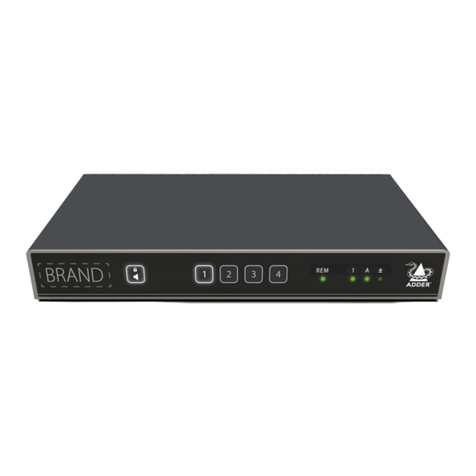
ADDER
ADDER ADDERView Secure AVS 2114 quick start
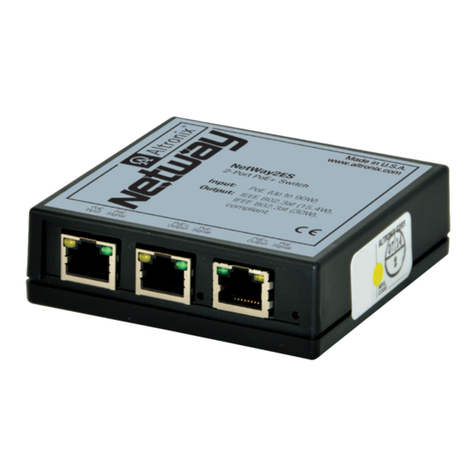
Netway
Netway NetWay2ES Series installation guide
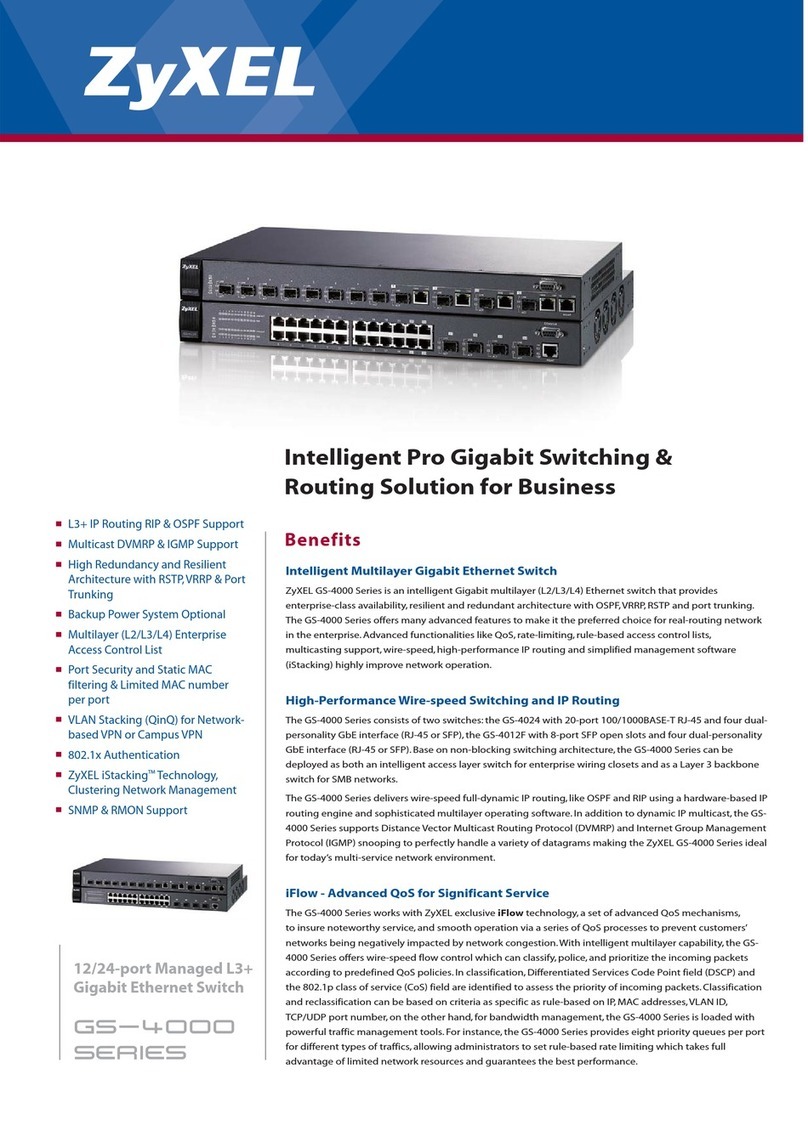
ZyXEL Communications
ZyXEL Communications GS-4012F Specifications
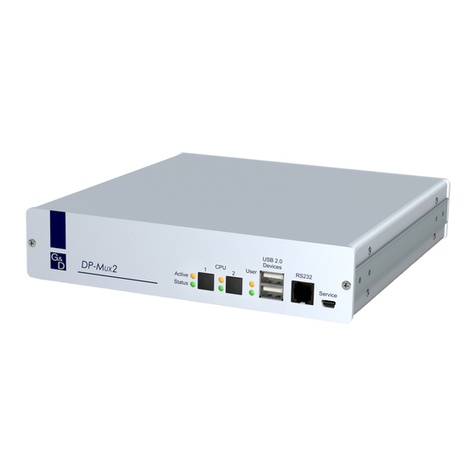
G&D
G&D DP-MUX2-USB Installation and operation
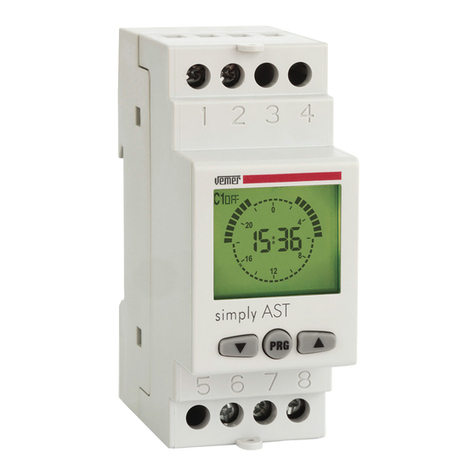
Vemer
Vemer memo AST1 user manual
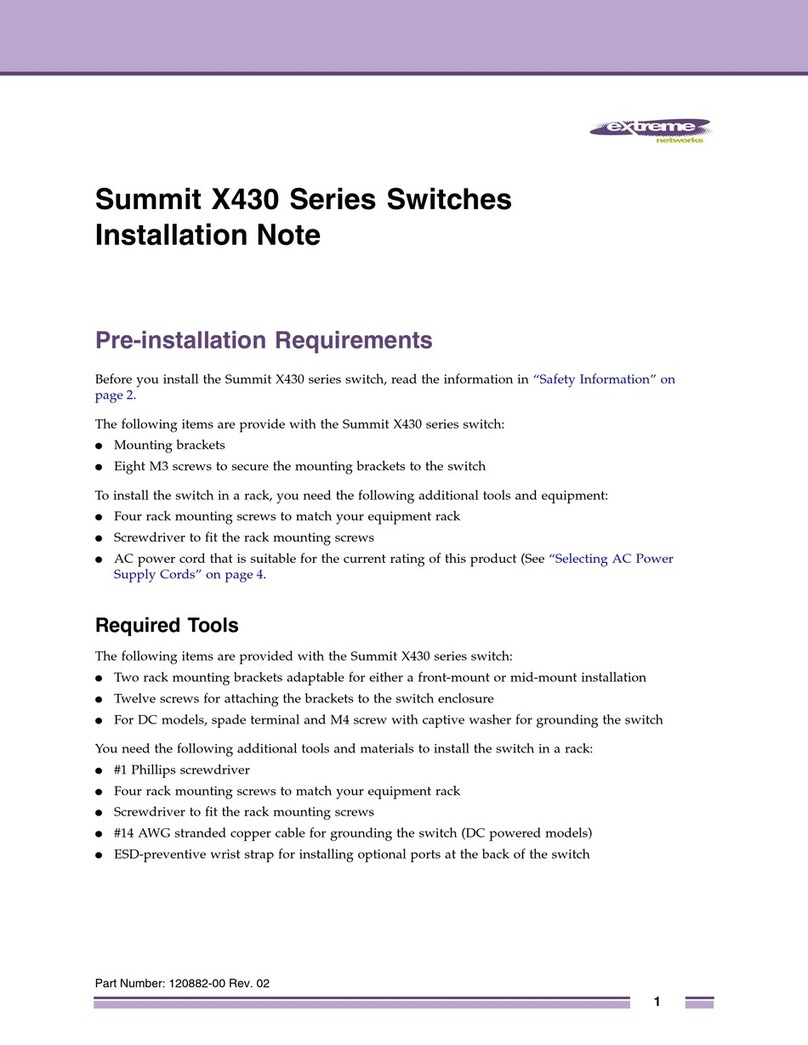
Extreme Networks
Extreme Networks Summit X430 Series Installation notes
